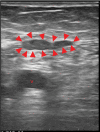A preoperative parathyroid scan is important for the total removal of the transplanted parathyroid tissue in recurrent secondary hyperthyroidism: A case report and literature review
- PMID: 36595874
- PMCID: PMC9794238
- DOI: 10.1097/MD.0000000000032453
A preoperative parathyroid scan is important for the total removal of the transplanted parathyroid tissue in recurrent secondary hyperthyroidism: A case report and literature review
Abstract
Rationale: Secondary hyperparathyroidism was one of mineral and bone disorders owing to chronic kidney disease. Patients who suffer from secondary hyperparathyroidism would receive medical treatment or parathyroidectomy with or without autotransplantation (AT). However, some patients receiving parathyroidectomy with AT have recurrent hyperparathyroidism, which impacts their lives. Patients with recurrent hyperparathyroidism may present persistent hypercalcemia and hyperphosphatemia, which would cause cardiovascular disease, like atherosclerosis.
Patient concerns: A 63-year-old female of Asian descent with chronic kidney disease who suffered from recurrent hyperparathyroidism for twice. The patient underwent parathyroidectomy with AT in the left thigh when secondary hyperparathyroidism happened. After 3 months, recurrent hyperparathyroidism happened.
Diagnosis: The patient was diagnosed with recurrent hyperparathyroidism due to chronic kidney disease with hyperparathyroidism status post parathyroidectomy with AT in the left thigh. Our patient also suffered from mineral and bone disorder.
Intervention: Two parathyroid adenoma in the left thigh were found. However, one of them was too small to found in the operation. Therefore, autograftectomy of the large one was performed. However, hyperparathyroidism happened again. This time, the autograftectomy was performed under dual phase Tc-99m MIBI (99m Tc-methoxy isobutyl isonitrile) parathyroid scintigraphy and it succeeded.
Outcomes: After secondary autograftectomy, the value of intact parathyroid hormone was surveyed immediately and dropped by two-third followed by gradual reduction in the following weeks. The calcemia and phosphatemia were back to normal gradually.
Lessons: In our case, importance of scintigraphy in the parathyroidectomy was confirmed.
Copyright © 2022 the Author(s). Published by Wolters Kluwer Health, Inc.
Conflict of interest statement
The authors have no funding and conflicts of interest to disclose.
Figures






Similar articles
-
Persistent and recurrent hyperparathyroidism after total parathyroidectomy with autotransplantation.Ann Surg. 2002 Jan;235(1):99-104. doi: 10.1097/00000658-200201000-00013. Ann Surg. 2002. PMID: 11753048 Free PMC article.
-
Tc-99m-MIBI scintigraphy for recurrent hyperparathyroidism after total parathyroidectomy with autograft.Ann Nucl Med. 2003 Jun;17(4):315-20. doi: 10.1007/BF02988528. Ann Nucl Med. 2003. PMID: 12932116 Clinical Trial.
-
Double-phase Tc-99m MIBI scintigraphy in secondary hyperparathyroidism relapsing after parathyroidectomy and removal of a parathyroid autograft.Clin Nucl Med. 1996 Aug;21(8):609-11. doi: 10.1097/00003072-199608000-00003. Clin Nucl Med. 1996. PMID: 8853911
-
Treatment for secondary hyperparathyroidism focusing on parathyroidectomy.Front Endocrinol (Lausanne). 2023 Apr 20;14:1169793. doi: 10.3389/fendo.2023.1169793. eCollection 2023. Front Endocrinol (Lausanne). 2023. PMID: 37152972 Free PMC article. Review.
-
Preoperative localization and radioguided parathyroid surgery.J Nucl Med. 2003 Sep;44(9):1443-58. J Nucl Med. 2003. PMID: 12960191 Review.
References
-
- Kidney Disease: Improving Global Outcomes (KDIGO) CKD-MBD Update Work Group. KDIGO 2017 clinical practice guideline update for the diagnosis, evaluation, prevention, and treatment of chronic kidney disease-mineral and bone disorder (CKD-MBD) [published correction appears in Kidney Int Suppl (2011). 2017 Dec;7(3):e1]. Kidney Int Suppl. 2017;7:1–59. - PMC - PubMed
-
- Kakani E, Sloan D, Sawaya BP, et al. . Long-term outcomes and management considerations after parathyroidectomy in the dialysis patient. Semin Dial. 2019;32:541–52. - PubMed
Publication types
MeSH terms
Substances
LinkOut - more resources
Full Text Sources
Medical

